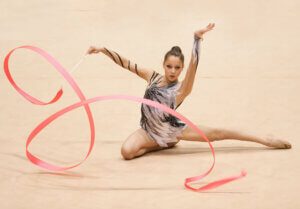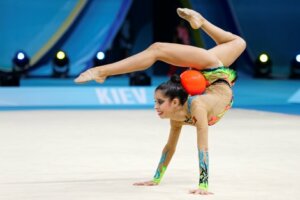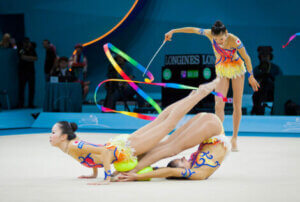Rules of Competitive Rhythmic Gymnastics

Rhythmic gymnastics is a sport with originals in classical ballet, gymnastics, and dance. During competitions, competitors perform routines, with or without apparatus, which they have to execute with harmony, beauty, and grace.
Then, after each routine, a panel of judges assess their performance and award them with a score.
Although creativity and originality are important aspects, there are also technical and ethical standards that athletes need to adhere to. The governing body responsible for these rules is currently the International Gymnastics Federation (FIG, in French), which regulates all aspects of international competitions.
Basic rules of competitive rhythmic gymnastics
Understanding all the rules and technical regulations of rhythmic gymnastics can be difficult, especially for beginners, so let’s start with the basic concepts that apply for the main international competitions.
Competition format: rhythmic gymnastics
Currently, rhythmic gymnastics can be practiced individually or in groups of five. However, until 1994, the most common format for international competitions was for teams to compete with six members.
Depending on the type of routine, competitors from the same team have to use either the same or different apparatus. In so-called mixed apparatus routines, three competitors use one apparatus, while the remaining two use a different one.

For individual competitions, routines normally last between 75 to 90 seconds. Team routines normally last between two minutes and 15 seconds and two minutes and 30 seconds.
In both formats, the competitors perform their routines on a carpet which measures roughly 39 x 39 feet.
Individual and group classification system
Classification can vary slightly depending on the event or competition. In the Rhythmic Gymnastics World Championships and most continental championships, there’s an established format. For individual competitors, this looks as follows:
- Competition I is the first stage of classification. Competitors perform four routines and receive a score for each. The sum of these scores makes up their final score.
- Competition II is the final of the general competition and involves the 24 best-scoring athletes. Despite the numbering, this actually happens after Competition III.
- Competition III is the final of the apparatus contest, in which the eight highest-scoring athletes compete in the first apparatus qualifying phase. This happens after Competition I, except when there’s Competition IV.
- Competition IV is occasionally performed in teams but doesn’t consist of separate group competitions. This involves the twelve best scores from each country (three scores per apparatus) in the qualification stage.

The team category doesn’t have a qualifying stage and consists of the following two phases:
- Competition I is the general competition. Teams perform two routines (identical and mixed apparatus) and the sum of the two scores makes up their final score.
- Competition II is the grand final with apparatus. This is contested by the eight highest-scoring teams from the first stage.
The Olympic Games are slightly different from all the other international competitions in that only a general competition takes place for both individuals and groups.
Scoring system: rhythmic gymnastics
A panel of judges assesses the competitors’ routines in accordance with the Scoring Code, which the FIG reviews every four years.
According to the current code (2017-2020), the score for a competitor’s routine consists of the sum of scores for Difficulty (D) and Execution (E). Each of these is out of a maximum of ten points, so the maximum final score is out of 20.
There are also penalties for mistakes during the routine, which results in point deductions.
Apparatus
The FIG chooses which pieces of apparatus the competitors need to use in each category. However, only four of the five available pieces of apparatus are selected in the same competition.
These five are the hoop, ball, clubs, ribbon, and rope, but the rope has been absent from the senior category since 2011. Then, depending on the category, these types of apparatus will have standard measurements.
Rhythmic gymnastics is a sport with originals in classical ballet, gymnastics, and dance. During competitions, competitors perform routines, with or without apparatus, which they have to execute with harmony, beauty, and grace.
Then, after each routine, a panel of judges assess their performance and award them with a score.
Although creativity and originality are important aspects, there are also technical and ethical standards that athletes need to adhere to. The governing body responsible for these rules is currently the International Gymnastics Federation (FIG, in French), which regulates all aspects of international competitions.
Basic rules of competitive rhythmic gymnastics
Understanding all the rules and technical regulations of rhythmic gymnastics can be difficult, especially for beginners, so let’s start with the basic concepts that apply for the main international competitions.
Competition format: rhythmic gymnastics
Currently, rhythmic gymnastics can be practiced individually or in groups of five. However, until 1994, the most common format for international competitions was for teams to compete with six members.
Depending on the type of routine, competitors from the same team have to use either the same or different apparatus. In so-called mixed apparatus routines, three competitors use one apparatus, while the remaining two use a different one.

For individual competitions, routines normally last between 75 to 90 seconds. Team routines normally last between two minutes and 15 seconds and two minutes and 30 seconds.
In both formats, the competitors perform their routines on a carpet which measures roughly 39 x 39 feet.
Individual and group classification system
Classification can vary slightly depending on the event or competition. In the Rhythmic Gymnastics World Championships and most continental championships, there’s an established format. For individual competitors, this looks as follows:
- Competition I is the first stage of classification. Competitors perform four routines and receive a score for each. The sum of these scores makes up their final score.
- Competition II is the final of the general competition and involves the 24 best-scoring athletes. Despite the numbering, this actually happens after Competition III.
- Competition III is the final of the apparatus contest, in which the eight highest-scoring athletes compete in the first apparatus qualifying phase. This happens after Competition I, except when there’s Competition IV.
- Competition IV is occasionally performed in teams but doesn’t consist of separate group competitions. This involves the twelve best scores from each country (three scores per apparatus) in the qualification stage.

The team category doesn’t have a qualifying stage and consists of the following two phases:
- Competition I is the general competition. Teams perform two routines (identical and mixed apparatus) and the sum of the two scores makes up their final score.
- Competition II is the grand final with apparatus. This is contested by the eight highest-scoring teams from the first stage.
The Olympic Games are slightly different from all the other international competitions in that only a general competition takes place for both individuals and groups.
Scoring system: rhythmic gymnastics
A panel of judges assesses the competitors’ routines in accordance with the Scoring Code, which the FIG reviews every four years.
According to the current code (2017-2020), the score for a competitor’s routine consists of the sum of scores for Difficulty (D) and Execution (E). Each of these is out of a maximum of ten points, so the maximum final score is out of 20.
There are also penalties for mistakes during the routine, which results in point deductions.
Apparatus
The FIG chooses which pieces of apparatus the competitors need to use in each category. However, only four of the five available pieces of apparatus are selected in the same competition.
These five are the hoop, ball, clubs, ribbon, and rope, but the rope has been absent from the senior category since 2011. Then, depending on the category, these types of apparatus will have standard measurements.
All cited sources were thoroughly reviewed by our team to ensure their quality, reliability, currency, and validity. The bibliography of this article was considered reliable and of academic or scientific accuracy.
- REGLAMENTOS, NORMATIVAS Y PROTOCOLOS. Web oficial Federación Española de Gimnasia. Extraído de: http://rfegimnasia.es/
- Reglamentos. Web oficial Federación Internacional de Gimnasia. Extraído de:://www.gymnastics.sport/site/rules/rules.php
This text is provided for informational purposes only and does not replace consultation with a professional. If in doubt, consult your specialist.








